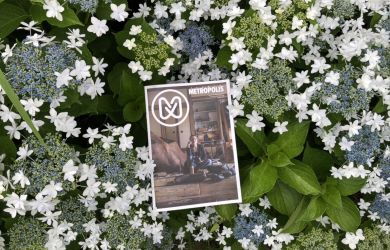
Originally published on metropolis.co.jp on June 2012

Under the cover of darkness, a thief lurks in the back streets of Omotesando and swipes shirts, blankets, socks and whatever else it can get its dirty little mitts into.
The thief, in this instance, has a large furry tail, a pointed snout and a girth large enough to drag large garments into to the ether, and has stolen enough items over the past few weeks to run a second-hand clothes stall at a flea market.
It’s called a hakubishin and until now the creature had happily co-existed with our family as a night time novelty that we occasionally sighted scampering along our back fence. But it has taken to burglary on a large scale, making off with many yen’s worth of our wardrobe that it picks off a rack we use to dry our clothes on our open-air terrace.
It has even made off with a sneaker, although that was found, a day later, discarded in the garden of an adjacent apartment block. Each day is something of a treasure hunt in our neighborhood as lost items turn up on the street, in bushes, and draped over parked bicycles.
Our daughter has just one school uniform shirt remaining, which makes for a busy washing schedule, and she and her sister have taken to regaling people with stories of “the animal that steals our clothes.”
It took some time for us to realise what exactly had been happening on our terrace at night: initial suspects were the crows furnishing their nests for springtime, but after my husband caught the animal red-handed—he reported seeing “something with fur” dragging one of his shirts across our small ground-floor terrace early one evening—all bets were off.
The hakubishin (not to be confused with another urban dweller, the tanuki) is known in English as a masked palm civet, and a small amount of research reveals it really isn’t all that pleasant to have skulking around in one’s backyard. Native to India, China, and the jungles of Southeast Asia, it has grey fur, a huge fluffy tail, and a white stripe down its pointed nose. The initial description makes it sound almost cute. Weighing up to six kilograms, it marks its territory by dragging its anal glands on the ground, has a ferocious set of sharp, pointed teeth, and feeds on rodents as well as anything else that takes its omnivore fancy. Oh—and it was also held partially responsible for the spread of SARS.
Definitely not cute, and not something to be welcomed to the neighborhood.
Queries to our building management about the feral thieving hakubishin were met with surprise, and after they conducted their own inquiries we were told, “It comes from China,” which I think was intended as: “It’s not our fault.”
The Shibuya ward office was also consulted, advising that the haukbushin, despite being an introduced species, was a protected animal (not that we want it dead!).
We really don’t know why it is stealing our clothes after many years of co-existence—and it is something of a puzzle, as nothing published refers to the hakubishin’s penchant for cloth items.
They do play a part in producing the world’s most expensive coffee, however. In Indonesia and the Philippines the creatures are fed coffee beans that, once defecated, produce a desirable aromatic blend. Alas, there are no coffee plantations in the Omotesando district and our resident hakubishin remains content with simple thievery.
Until the crime spree comes to an end, we will bring our clothes rack inside at night and hope for no stinky anal secretions or minor SARS outbreak in our yard.
Have something to say about this story? Share your comments below.





